Perennial asters are members of various genera in the Asteraceae family, including Aster, Eurybia, and Symphyotrichum. They are native to the United States, Europe, and Asia.
There are numerous species and cultivated varieties with heights ranging from six inches to over six feet tall.
Instead of large showy flowers, most have masses of tiny, daisy-like blossoms that measure between one-half and one inch in diameter.

We link to vendors to help you find relevant products. If you buy from one of our links, we may earn a commission.
With a vigorous growth habit, they readily naturalize via their extensive root systems and by self-sowing. The challenge is to be able to enjoy them without letting them take over your yard.
In this article, we offer food for thought with 21 tips for how to manage perennial asters in your landscape.
Here’s what’s in store:
What You’ll Learn
Even though they are not labelled as an invasive species by the USDA, aggressive growers can cause headaches instead of joy – unless they are well managed.
Let’s find out how to turn unruly into manageable, right now.
The Good, the Bad, and the Ugly
Here in the Northeast, a profusion of blue, pink, purple, and white starry perennial asters mark summer’s last and glorious hurrah before the scarlet hues of autumn herald cold days to come.
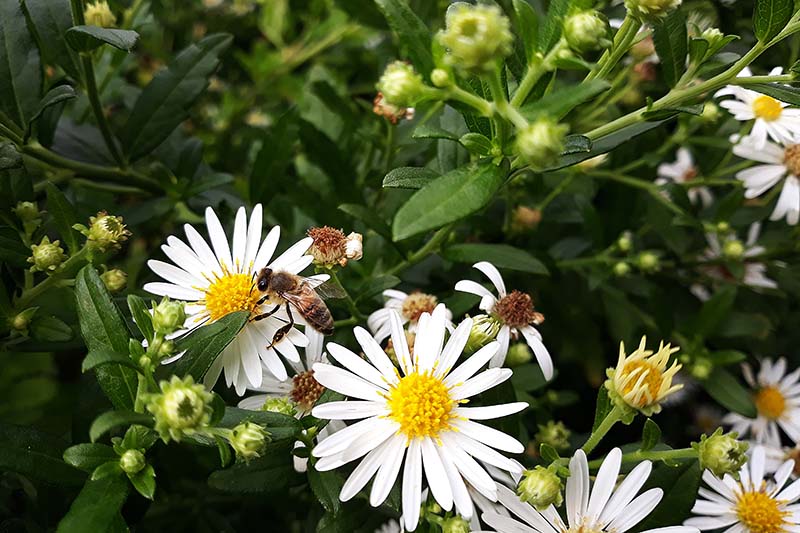
As mentioned, Symphyotrichum, especially native species, naturalize with vigor.
Returning each spring, these perennials take up more and more garden real estate each year, multiplying via a root system of thick rhizomes, and self-sowing with abandon.
They attract a host of bees, butterflies, moths, and other beneficial pollinators that are a constant presence, and a boon to all the plants in the garden.
At season’s end, the wildlife population shifts to foraging birds that are drawn to the seeds, attempting to consume them before they are dispersed on the breeze in clouds of fluffy, brown and white tufts.
As a nature lover, I welcome asters, especially native species.
However, in addition to naturalizing like it’s a competitive sport, there are often other challenges to contend with:
- Tall varieties may become top heavy, with “leggy” stems. Sometimes, especially after heavy rain, they tend to flop over.
- A hot, dry summer is likely to cause the lower leaves to wither and drop, revealing stems that look like skinny bare legs.
- An especially damp summer may result in a coating of blotchy, gray powdery mildew on the leaves.
- While neither hot and dry nor damp summer conditions are likely to spoil the flowers, the overall appearance of plants may become unwieldy and ragged.
You can meet these challenges with proactive measures that can help to contain their spread, and maintain their appearance.
Let’s find out what they are.
How to Manage Perennial Asters
To successfully manage asters, you need to accommodate their natural tendencies, but on your terms.
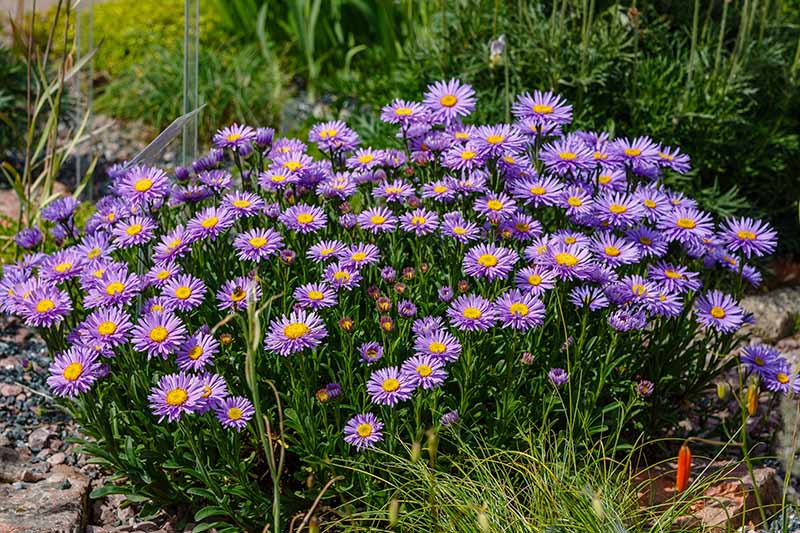
Here are 21 tips for keeping asters in line, broken down into four categories:
Control Spreading
There are some excellent ways to keep plants from taking over the yard, including:
- Grow them in containers. Choose pots with widths that can accommodate mature plant dimensions, with a depth of at least 12 inches.
- Deadhead after blooming, to prevent seeds from dropping. Cut the flower stems as they finish blooming, or clearcut entire plants just after the last blossoms fall, before the seeds disperse.
- Plant in a raised bed with a solid bottom to inhibit root spread. Make it an island unto itself, away from other gardens, to reduce the number of self-sown seedlings that pop up.
- Divide plant clumps in the spring to reduce their size and disrupt root spread.
- Manually remove any unwanted seedlings, and place them on the compost pile. To prevent seedlings from growing in the lawn, you can apply a pre-emergent herbicide in early spring. Be sure to use one that won’t kill the grass, and follow the package instructions.
- Plant them in a location bounded by physical barriers, like a foundation bed beside a paved front path or patio, to inhibit root spread and prevent seeds from dropping on soil.
- Choose a location where plants may spread without taking over gardens or invading lawns. A fenced roadside property perimeter where you can control their spread is a good option.
- Place landscaping fabric over the soil around your plants to inhibit seedling growth from self-sowing.
- Choose smaller, more manageable varieties such as the petite Alpine aster, A. alpinus, that tops out at six to 12 inches tall.
- Select hybrid cultivars. Hybrids have a higher chance of being infertile, so self-sown seed may not germinate.
Manage Legginess
A “leggy” plant is one with stems that have grown so top-heavy, it can no longer support them on its own.
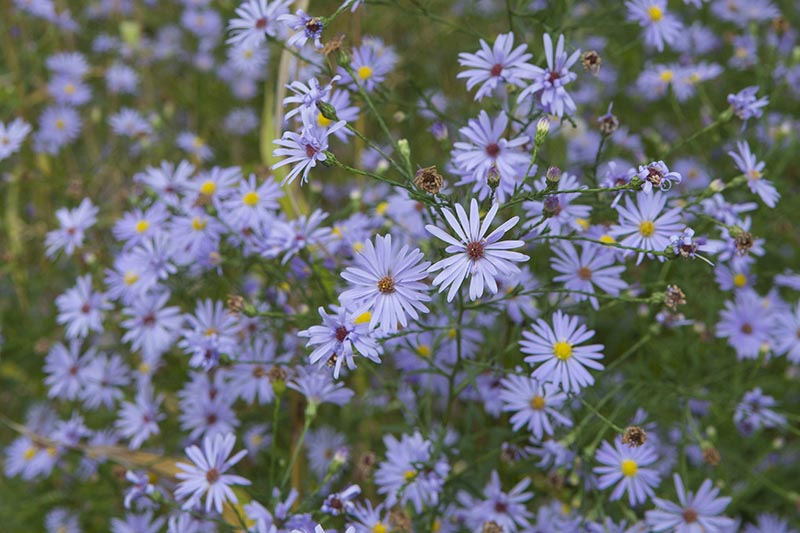
This creates a split-open appearance in the clump and can cause stems to break, not only making them unsightly, but also rendering them vulnerable to disease.
Here’s what to do:
- Pinch off growing tips early in the spring to promote a more compact, bushy appearance.
- Stake tall species and cultivars like the New England Aster, S. novae-angliae, before they begin to flop over. You can use something attractive and natural looking, like twig fencing.
- Place shorter varieties in front of taller ones, to help those in the rear position to remain upright.
- Don’t overfertilize, especially native types. This may contribute to leggy growth.
Address Bare Legs
While naturalized flora requires little supplemental water, during a heatwave they can use a little help. Here’s what to do:
- If hot weather is predicted, water deeply in advance. Plants that begin to dehydrate are likely to conserve water, starting from the bottom. First the lower leaves will wither, then they turn brown and drop, leaving bare stems.
- You can place shorter varieties in front of taller ones to hide the bare stems of those in the back, which is especially desirable if the lower portions are dry and leafless. And as mentioned, this also provides support for the tall stems.
Inhibit Fungal Growth
A common issue is a fungal condition called powdery mildew. It generally doesn’t spoil the flowers, but gives the leaves a mottled gray appearance.
Here’s how to keep it at bay:
- When you are planting, check your seed packet and use mature dimensions as your guide. Make sure you provide ample room between plants, to allow for good airflow and reduce the relative humidity.
- Weed the garden regularly to maintain good airflow and minimize the relative humidity surrounding your plants.
- Be careful not to overwater while new plants are becoming established, and during dry spells. Moist, damp conditions are ideal conditions for fungal growth.
- When watering, aim the hose at the base of the plants, and avoid wetting the leaves. Excessive moisture on the foliage may activate fungal spores.
- Check plants regularly – especially during damp conditions – for signs of fungal infection, and remove affected leaves. You can apply a fungicide to prevent the disease from spreading.
Start Small and Grow
Wild and wooly asters may not be for everyone, but with 21 ways to tame their natural tendencies, there’s no need to be fearful of their behavior in the garden.
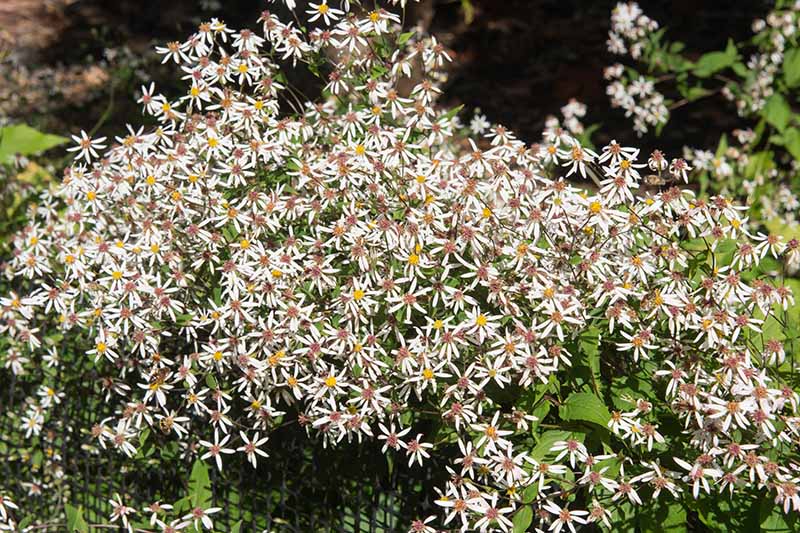
Start small when choosing a variety or two to cultivate for the first time. A container or raised bed with a bottom will afford you the opportunity to enjoy the blooms without worrying about the plants taking over.
Consider a native variety to attract local pollinators and birds, and add a birdbath or bird feeder to the setting while you’re at it.
In time, you may want to expand into the garden, perhaps along that roadside perimeter.
The more you tend to your plants, the more first-hand knowledge you will gain of how they behave.
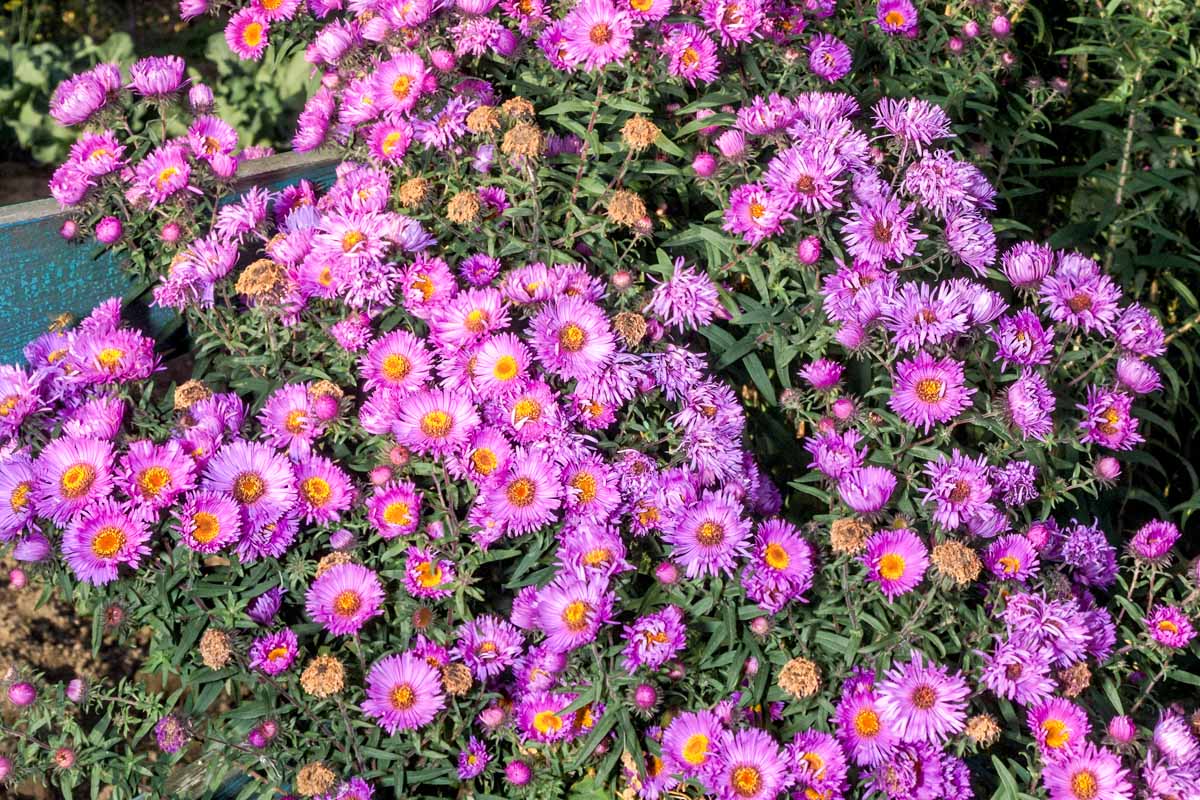
And, if you divide them every few years in the spring to keep them healthy and manageable, you know what? You may just find that there’s plenty of room in your outdoor living space for your well-behaved perennial asters.
How are you managing your asters? Do you have any tips to share? Let us know in the comments below!
If you’re interested in more information about growing perennial asters, you’ll need these guides next:

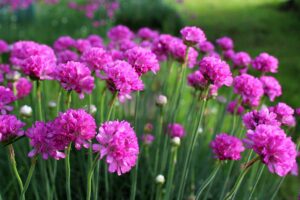
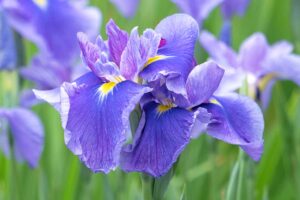

I bought 2 asters at the same time, planted them next to each other in the garden. One bloomed beautifully and the other didn’t even have a single bloom. Any thoughts or insight on this? Thanks
Hi Mary Anne –
It’s so frustrating when this happens. It’s possible that the non-bloomer was overfed with a nitrogen-rich fertilizer during its cultivation before purchase. Assuming it’s a perennial species, it may surprise you with better results next year.
I have a question. My asters are full of blooms right now. Must I deadhead them? If I do not will they stop blooming, or can I cut them back afterwards and get another bloom in the fall?
TIA
Hello Valerie –
There is no need to deadhead. If you choose to deadhead, wait until all blossoms on a stem have bloomed before cutting the entire stem back to its point of origin. Cutting back in this way encourages a second bloom later in the season.
Hello, can you list a few of the native asters? Thanks very much
Hi Valerie –
US native perennial asters include:
Aromatic
Blue Wood
Calico
Heath
New England
New York
Silky
Sky Blue
Smooth
Stokes’
You can read about them in our article, 11 Perennial Aster Species for Summer’s Last Hurrah. Note that #11 is a non-native species, the Tatarian aster.